
Revision note:. We have found trade magazine reviews of two Boxers (201 and 202, in Cash Box). We now have confirmation on Boxer 111 by Russell (Saxy) Taplin, which displaces 110 by Harold Harris as the last release on the label. We have also added several label photos (our thanks to Jeff Peters for the Boxer 202 78 rpm labels) and, with help from Bob Eagle and Paul Vernon, upgraded our bio on Bobo Jenkins.

Boxer was one of the myriad boutique labels that sprang up in the postwar years in Chicago. It lasted around 18 months, producing six releases. The label was established by Johnny Moore, who was a janitor at Englewood High School but who got into the music business when he discovered the El Dorados in the halls of the school building. He became the vocal group's manager and got them signed to Vee-Jay in 1954. In 1959 Moore decided to form a label, which he called Boxer. His business partner was Eva Russell, who is mentioned in a reference to Boxer being picked up by Allstate Distributors (Cash Box, May 16, 1959, p. 26); the house publisher was obviously named after the two of them. Moore may have had family or other connections in Michigan, because two of his acts, Jesse and the Sequins and Bobo Jenkins, were recruited from that state.
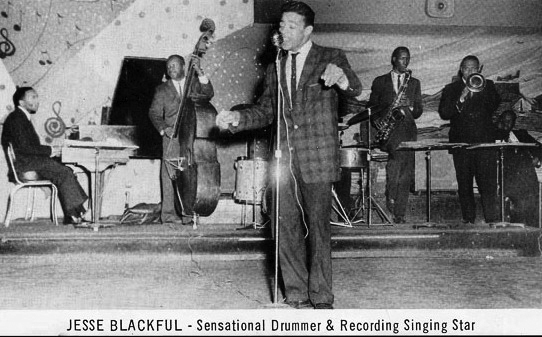
Jesse and the Sequins was a vocal group with a male lead and three females in support. All four members came from Battle Creek, Michigan. The group was formed in 1958 from a union of Jesse Blackful (lead singer, drummer, and composer) with a girl group called the Dreamers. The Dreamers were sisters Johnella and Faye Askew, and Joyce Jones. They had been performing in amateur shows at their high school, Battle Creek HS, and at the Hamblin Community Center, where they came together with Blackful.
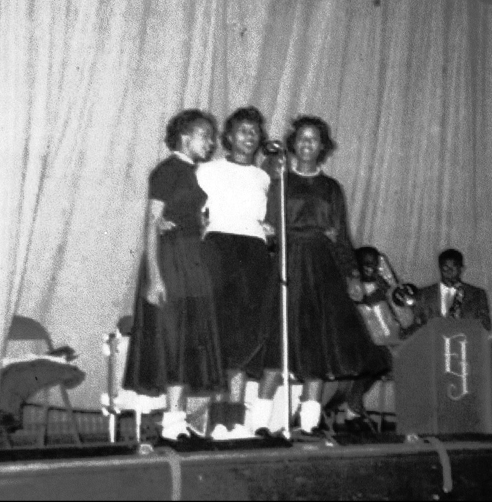
Not long after getting together they were discovered by Johnny Moore performing at an amateur show. On a four-tune session, two sides were cut with backing from the Lefty Bates Band. Then the girls were pulled aside and asked to do two more sides with Bates but without Blackful. One was a vocal rendition of George Shearing's jazz number, “Lullaby of Birdland,” and the other required a few vocal interjections to the instrumental “Say Whoa.”
Within days of the session, which must have taken place in April 1959, Jesse and the Sequins appeared on a stage show. This probably took place at the Tivoli, because it featured Big Maybelle (whom Johnella Askew recalled on stage), the Cadillacs, and Priscilla Bowman, all backed by the Lefty Bates Band.



Boxer 201 has also shown up as a white-label promo. Some copies of the regular issue 45 credit "So Weak" to "Moore-Blackfel"; the error is corrected on the DJ copies. The uptempo “So Weak,” with a perky cha cha beat then in vogue, got local plays in Detroit and Pittsburgh, but the slow, lumbering “Hold My Hand” probably generated little. The record was considered commercial enough for Mel London to pick it up and rerelease it on his Profile label in 1960, taking most of the label copy directly off Boxer 201.
Boxer 203 has shown up only on 45. There were promos for this one, but they carry the same label design as the regular release. “Lullaby of Birdland” showed off the girls' vocal talents to some effect, so it is a shame they did not get an opportunity to record some R&B without Jesse. While the Sequins were never heard from again, one Jesse Blackful played bass on bluesman Johnny Littlejohn's first session, four sides recorded in Chicago for the Margaret label in 1966.
Jesse Blackful (lead voc%); The Sequins: Johnella Askew, Faye Askew, Joyce Jones (voc%*^); Lefty Bates (eg, dir); other musicians unidentified.
Chicago, April 1959
| BX-303 | So Weak (Moore-Blackful)% | Boxer 201, Profile 4008 | |
| BX-304 | Hold My Hand (Moore-Blackful)% | Boxer 201, Profile 4008 | |
| BX 305 | Lullaby of Birdland (Shearing-Foster)* | Boxer 203 | |
| BX 306 | Say Whoa (Moore-Russell)^ | Boxer 203 |
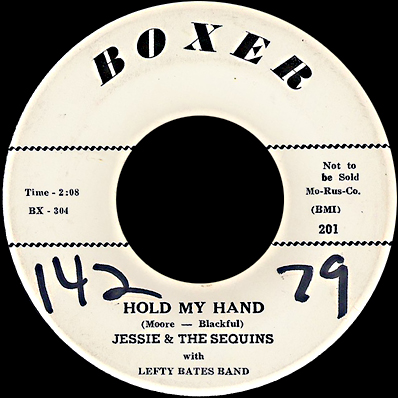

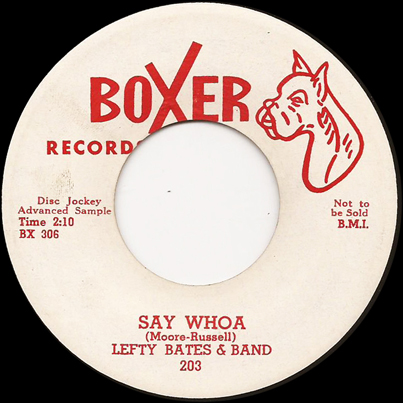
Boxer 201 was rushed into release; it was reviewed in Cash Box on April 25, 1959 (p. 46).
William "Lefty" Bates was born in Leighton, Alabama, March 9, 1920. He was raised in St. Louis and went to Vashon High School. While still at Vashon Bates, who played guitar, formed a vocal/string band, the Hi-De-Ho Boys, a kind of ensemble that was extremely popular in the black community during the 1930s and the 1940s. Bates settled in Chicago, where the Hi-De-Ho Boys were already being featured at the old Club DeLisa in 1938.
Bates had to leave the Hi-De-Ho Boys to serve in World War II. Following the war he joined the quartet called the Aristo-Kats, who successfully recorded two sessions for RCA Victor in 1946 and 1947. When the Kats broke up in 1948, Bates rejoined the Hi-De-Ho Boys. The group's last engagement at the Club DeLisa ended in early May 1950. Shortly before the group finished its years at the club, the Hi-De-Ho Boys cut two sides for Mayo Williams' Harlem label.
In 1952 Bates put together a trio with Quinn Wilson (bass), and Horace Palm (piano), playing regularly with this lineup for the rest of the decade (sometimes a horn player was added to make it a quartet). The Bates combo could be heard in such establishments as Duke Slater's Vincennes Lounge (601 East 36th), the Shalimar Club (5659 Wentworth), Banks' Trocadero Lounge (4719 Indiana), and Spruce's Duck Inn Lounge (5550 South State). When Bates got the call for a studio session, he usually brought Palm and Wilson along.
Bates recorded minimally under his own name. Besides the release on Boxer, he had one on United (1957), a session on Tommy Jones' Mad label (1958), and two on Apex (1959). With Boxer, he was responsible for four sides: two backing up Jesse and the Sequins, one with the Sequins alone, and one that featured his band. The Boxer release did like all of the others—it got no traction—but it is unlikely that Bates cared. He was regularly employed in the clubs and for years was the guitar player most in demand for recording sessions. Bates' run in the studios began with Chance in 1952. He laid down countless tracks for Vee-Jay, but also accepted work with much smaller operations, such as Club 51. Bates's last musical affiliation was with the Ink Spots, during the 1970s. Because of the onset of Alzheimer's disease, Lefty Bates had to go into a nursing home in 2001. He died on April 7, 2007.

Bobo Jenkins was born John Pickens Jenkins (January 7, 1916, in Forkland, Alabama). Our thanks to Bob Eagle for infromation about his full name and date of birth. Growing up in Alabama, Jenkins largely sang gospel. After serving in the Army, from 1942 to 1944, he settled in Detroit, working on an automobile assembly line. He gradually taught himself guitar, and was soon working in Detroit clubs, singing and playing downhome blues.
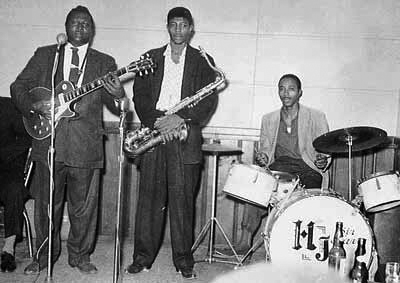
In 1954 he landed one release on Chess. A stray track made for J V B around this same time was not issued till years later. In 1957 Jenkins tried Fortune Records, a small Detroit label known for its eccentric business practices. Jack and Devora Brown, the owners, released Fortune 838 (which featured a remake of “Sweet Home Chicago” called “Baby Don't You Want to Go”) on 78 only. Nearly a decade later a Fortune 45 belatedly followed, substituting rehearsal tracks for the same titles. Another stray track would end up on a Fortune LP.
Paul Vernon (Real Blues Forum post of August 10, 2015) tells the story behind the Fortune 45:
The 45 of the Fortune is, indeed, a coupling of rehearsal takes, but it only exists because, in 1966, Mike Rowe visited Jack Brown and asked him to press up 200 copies of the 78 takes as a 45. When he took delivery of them, they were the rehearsal takes that Jack Brown had decided "were better". In all my years I have never seen a 45 of the 78 takes and I don't believe it was ever issued thus. Ergo ALL known 45's come from 1966 and contain the rehearsal takes. Mike was VERY pissed about this, and the story just told here came directly from Mike, who I've known for years.
Jenkins told at least one interviewer that he cut the Boxer single in 1955. For that to be the case, it would have to have been done in Detroit, and sold to Moore later. The actual sound of the Boxer—note the heavy rock and roll influence—is consistent with the 1959 date usually given, but it would be nice to be able to nail down the year, as well as the personnel. Willie Johnson is supposed to have been the lead guitarist, as on the McKinley Mitchell session (see below).
The Boxer release was part of a four side session; Fancourt and McGrath's Blues Records 1943-1970 provide the unissued titles as well as the personnel. Boxer 202 was rereleased some years later (different sources give conflicting dates) on the Detroit-based Duchess label.
After Boxer, Jenkins was responsible for two singles on Big Star, another label based in Detroit. Big Star 001 came out in 1960; two unissued tracks were made around 1962; finally, Big Star 024/33, with "Watergate Blues" as one of the titles, has to be from 1974 or thereabouts. Jenkins continued to perform in the Detroit area until his death on August 14, 1984.
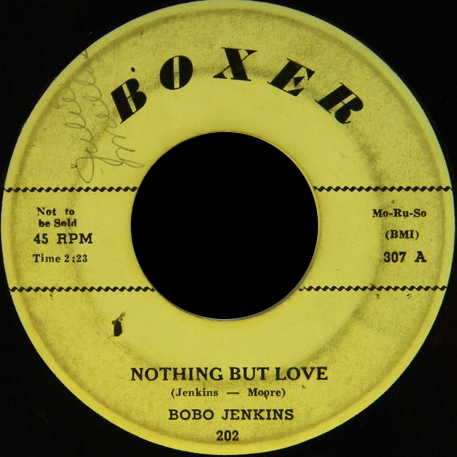
Bobo Jenkins (eg, voc); Willie Johnson (eg); Eddie Taylor (eg); Earl Phillips (d).
Chicago, 1959
| BX 307 | Nothing but Love (Jenkins-Moore) | Boxer 202 A, Duchess 101 B, Blues Obscurities LP 7, Big Star LP BS11-33 | |
| BX 308 | Tell Me Who | Boxer 202 B, Duchess 101 A | |
| That Woman | unissued | ||
| Reelin' and Rockin' | — |
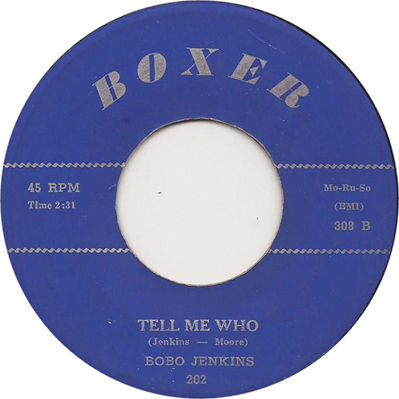
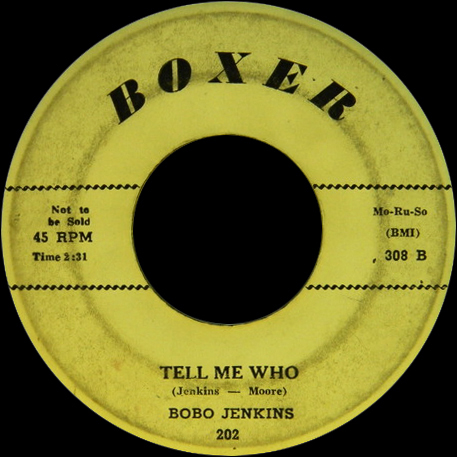
Boxer 202 was released on 78, with the dog label, and on 45 with the original plain label. Black on yellow DJ copies of the 45 are also known (the label is a color negative of the silver on blue plain Boxer design). Repros of Boxer 202 are in circulation (on 45, of course, with a somewhat washed out plain blue label).
Boxer 202 was reviewed in Cash Box on June 27, 1959 (p. 53). The date is consistent with a recording session in April, May, or early June 1959.
Bob Eagle and Paul Vernon have confirmed that the Duchess 45 is a straight reissue of Boxer 202. Our thanks to Bob Eagle for information about the reissues on LP.

For many record companies, 1959 marked the end of line for 78 rpm releases. Boxer 201 and 202 are known on 78 as well as 45 rpm. According to our current information, the remaining Boxers—203, 204, 110, and 111—were 45-only.
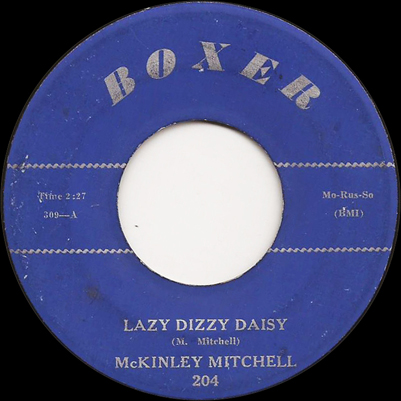
McKinley Mitchell, born in Jackson, Mississippi, December 25, 1934, was a distinctive rhythm-and- blues stylist of the first rank. His earliest experience in music was in church, and in 1950 at the tender age of sixteen he became lead for a Jackson-based gospel group, the Hearts of Harmony. A little later the group's manager moved to Springfield, Massachusetts, taking the group with him. There Mitchell attended Gloucester High. While still with the Hearts of Harmony, he tried his hand at secular music, working with the Tiny Button Quintet around Springfield during the mid-1950s. For two to three years Mitchell headed his own gospel group, the Mitchellairs, in Philadelphia.
By 1958, when Mitchell was ready to go solo, he was lured to Chicago by relatives who told him of the many clubs where he could work. Mitchell got his entry into the Chicago music scene at Pepper's Lounge, on 43rd Street, where he began opening for Muddy Waters.
The Boxer release on Mitchell was his first recording, in November of 1959. As the sides were made with guitarist Willie Johnson, drummer Billy Davenport, and another member of the Howlin' Wolf band, one could say they were blues with a rock 'n' roll beat. Few copies of the record were pressed (one estimate is 200). Its wild sound, courtesy of Willie Johnson's manic guitar, might have made it too fierce for radio programmers.
After his near-invisible Boxer release, Mitchell would go on to great success. In 1962 he hit nationally with "The Town I Live In" for George Leaner's One-derful label (see our King Kolax page for details). That began a long career recording in Chicago, with One-derful, Chess, Sandman, Black Beauty, Spoonful, and Big 3. After he moved to the South in 1976, Mitchell recorded for Chimneyville, Southern Biscuit, Malaco, and Retta's. McKinley Mitchell died in Chicago on January 18, 1986.
McKinley Mitchell (voc); Willie Johnson (eg); unidentified (b); Billy Davenport (d).
Chicago, November 11, 1959
| BX 309 (309—A on label) | Lazy Dizzy Daisy (Mitchell) | Boxer 204 A | |
| BX 310 (309—B on label) | Rock Everybody Rock (Mitchell) | Boxer 204 B |

The date for this session and the personnel come from Fancourt and McGrath's Blues Records 1943-1970.
To our present knowledge (which remains inadequate), 10 months went by before Moore decided to record one more artist.
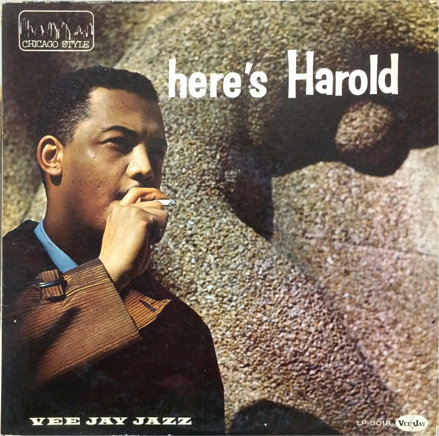
Harold Harris was a jazz pianist, who played, by the time he began recording, in a style that drew in roughly equal parts from Errol Garner and Red Garland. Harris was born in Lafayette, Indiana, on August 22, 1934. He graduated from Jefferson High School and enrolled at Purdue University, majoring in Sociology and Physical Education; he also began playing gigs in and around Lafayette. After two years in the US Army, he moved to Chicago in 1958, where he took a day job with the Welfare Department and played gigs at night, first in a duet with Lennell Glass, then a trio with Glass and George Harps. What little we know about Harris we've taken from the notes to his first Vee-Jay LP, released in 1961, which were written by Barbara J. Gardner.
The Vee-Jay notes do not, of course, mention anything about Boxer or about Harris's having done anything for the label. Apparently Johnny Moore caught the trio at the "small, obscure" club where they played most often; the Vee-Jay notes did not deign to identify it.
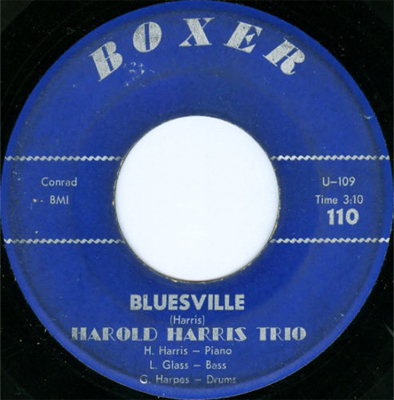
Harold Harris (p); Lennell Glass (b); George Harps (d).
Chicago, September 13, 1960
| U-109 | Bluesville (Harris) | Boxer 110 | |
| U-110 | Miles' Theme [If I Were a Bell] (Loesser) | P-Vine [J] PVCP-8183 | |
| U-111 | Get with It (Harris) | P-Vine [J] PVCP-8183 | |
| U-112 [?] | Misty (Garner) | Boxer 110, P-Vine [J] PVCP-8183 |
The drummer's last name is misspelled on the Boxer labels.
The date and titles for this session come from Tom Lord's Jazz Discography. But there the session is credited to Vee-Jay and in the bargain all four sides (identified as "Bluesville," "Theme," "Get with It" and "Misty") are said to be unissued. In fact the session was recorded for Boxer, and two sides were released on a late Boxer single (Moore put it in a new 100 series). Vee-Jay subsequently acquired the entire session but never did anything with it, and only one reissue derived from Vee-Jay has ever used any of the tracks.
Lord lists "Bluesville" as matrix U-110 when its release number was 110, and its matrix number, per the Boxer label, was U-109. If "Bluesville" was U-109, perhaps "Theme" (see below for the actual identity of this track) was U-110 (Lord listed it as U-109).
On the Boxer label, "Misty" has U-111 for a matrix number (and no music publisher listed).
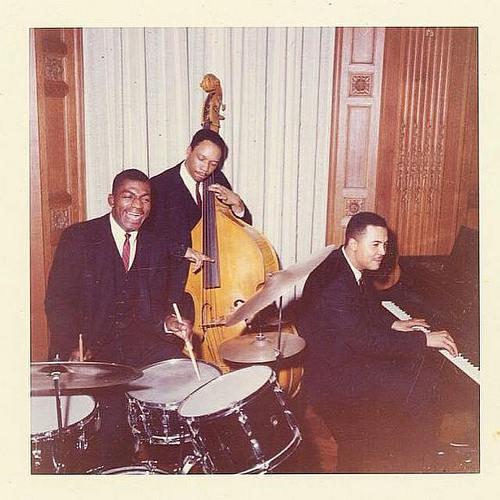
According to Gardner's notes, in December 1960 Al Williams, of the Four Step Brothers, heard the trio playing a National Guard Armory dance. Williams signed Harris to a management contract. In January 1961 Williams got the trio a job (the first contract was for 2 weeks, 3 nights a week) at the Playboy Club; the engagement was ultimately extended for at least two years. A contract with Vee-Jay soon followed the Playboy Club gig. Vee-Jay would record two Harris LPs.
A remake of "Bluesville" was included in Vee-Jay LP-3018, here's Harold. There was also a stereo release, LPS-3018. Stereo recording on anything pretty much rules out Boxer's involvement. Vee-Jay 408 coupled this "Bluesville" (which got two matrix numbers, 61-1981 and WRC-466) with "Swing Low" (61-1783). "Swing Low" was also on LP/LPS-3018; according to Lord, it was recorded on February 6, 1961, along with 11 other tracks. However, a version of "Bluesville" recorded at that session should have carried matrix number 61-1782. Though here's Harold was recorded in stereo, the reissues have been in mono.
According to Lord, there were two Japanese reissues up to 1994: Vee-Jay [J] 22YB2094 on vinyl, and 32YD1089 in CD format. So far as we know neither of these added anything to the original 10 tracks.
In 2004, a CD reissue of here's Harold on the Blue Moon label used the same 10 tracks as the LP. The CD gave February 6, 1961 as the recording date for all items.
The 1998 reissue ofhere's Harold on CD from the Japanese P-Vine label, PVCP-8183, was expanded to 18 tracks, adding the so-called "Miles' Theme," "Get with It" and "Misty" from the Boxer session and 5 other sides apparently also recorded for Vee-Jay. "Get with It" is credited to Harris on the P-Vine, while "Miles' Theme," credited to Miles Davis, is really "If I Were a Bell," which became a jazz standard after being recorded by Miles' quintet in 1956 (then by Red Garland's trio in 1957). As per the Wikipedia entry, "So closely is the tune associated with Miles Davis that it is often miscredited as one of his own original compositions." The P-Vine notes also give the February 6, 1961 session as the source for all of the tracks, which we know can't be right. Unfortunately, the 10-track CD is far easier to find.
The label to the Boxer release of "Bluesville" carries a publication credit to Conrad Music, one of Vee-Jay's house music companies. Apparently Johnny Moore had already sold his house music company (variously identified as Mo-Rus-Co, Mo-Rus-So, or Mo-Ru-So) to Jimmy Bracken.
In 1963 or thereabouts, Harold Harris made a second LP for Vee-Jay, LP and LPS 3036, Live at the Playboy Club, which included 7 tracks by the trio. The front cover shows the trio at the club with two Playboy bunnies, but the recording was not actually live, according to Lord, which means it was either recorded in the empty club or in a studio. There have been reissues on LP and CD. In 1995, after a long hiatus, Harris recorded two CDs at Sparrow Sound Design in Chicago: Bluesville + 3 and Luis Blue. These were eventually released on the Japanese Absord/Interplay label, but we doubt this was their first appearance on the market.
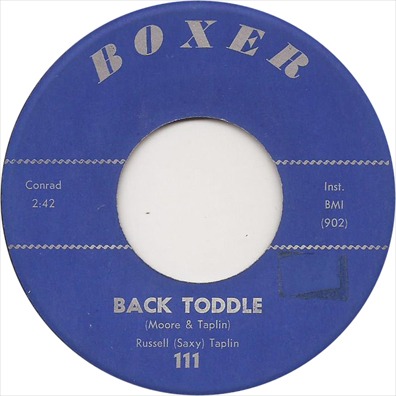
Bob McGrath's R&B Indies (an invaluable resource; we drew our basic listing of Boxer releases from the four-volume second edition) shows a 45 by outré singer Russell (Saxy) Taplin aka Saxie Russell (McGrath lists him under the latter name). We now have confirmation on the release, along with the release number, the matrix numbers, and the correct titles, courtesy of Dr. Robert Stallworth. As Saxie Russell, Taplin would be responsible for a couple more singles over the next decade, both in Chicago. He put out a weird dance number, “El Monkey,” on Ran-dee in 1964. His best known 45, “Psychedelic Soul”, was done in 1968 for Eddie Thomas's Thomas label. It drew enough interest to merit at least two rereleases.
Russell "Saxy" Taplin (voc); others unidentified.
Chicago, 1960
| 902 | Back Toddle (Moore-Taplin) | Boxer 111 | |
| 903 | The Shoop (Moore-Taplin) | Boxer 111 |
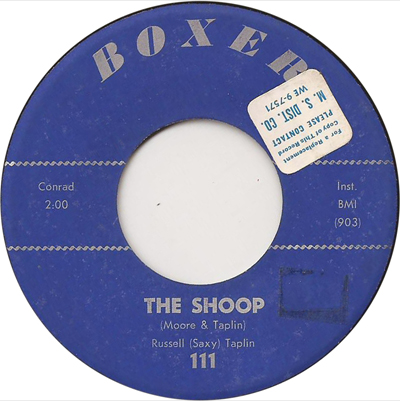
We are now able to document this elusive record, courtesy of Dr. Robert Stallworth. The McGrath listing misspells the first title as "Back Toodle." Although the matrix numbers are in a different series from any previous Boxer, the music publisher is again Conrad.
The Harold Harris session took place on September 13, 1960. The Saxie Russell could have been later, but we figure it was before the end of the year. It appears Moore had already had to sell his house music publishing company. The label hit the end of the road when Vee-Jay signed Harold Harris, in January or February 1961, and bought his Boxer session. None of the Boxers did anything commercially. Recording and releasing six singles had probably eaten up Johnny Moore's seed money, though selling the Jesse and the Sequins single to Mel London and the Harold Harris session to Vee-Jay must have brought him some recoupment. While the recording output was small, his label left an admirable musical legacy.
A second, unrelated Boxer label operated in Los Angeles from 1966 to 1968; it issued one single by Floyd Dixon and one by Tommy Bush.
Click here to return to the Red Saunders Research Foundation page.
Click here to return to Robert L. Campbell's Home page.